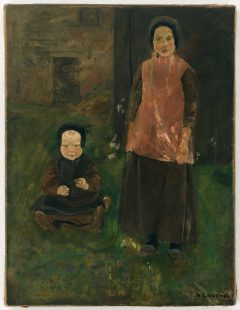Max Liebermann
Zwei holländische Mädchen
ca. 1882

Oil on cardboard on canvas
52 × 40 cm | 20 1/2 × 15 3/4 in
Signed
With the label of Galerie Thannhauser, Munich on the verso
The work has been registered for the addendum of the catalogue raisonné currently being prepared by Prof. Dr. Matthias Eberle, Berlin as no. 1882/10a
The work is accompanied by a certificate of authenticity issued by Prof. Dr. Matthias Eberle, Berlin
Galerie Thannhauser, Munich (1917); Kunsthaus Lempertz Cologne (1959); Stuttgarter Kunstkabinett (1962); Private Collection Switzerland
- Moderne Galerie Thannhauser München, "Nachtragswerk II", München 1917, plate 60
In the 1880s, Max Liebermann was already travelling regularly to the Netherlands to study rural and village life there and capture it in drawings, pastels and paintings. In his works from this period, Liebermann depicted men and women working at home, in the fields and going to church, children on their way to school or living together in orphanages and old men's houses. He is interested in how people live together, especially the subtle human relationships between siblings and family or village members. He explains his fascination with the simple life in a letter to his brother Felix as follows: At the kitchen table, cowherd, girl, farmhand, lordship all sit together and eat from the same bowl. Everything is on first-name terms like a big family. There is no poverty here. [...] humanity [is] staid and right-thinking. 1) The painting "Zwei holländische Mädchen", which must have been painted around 1882, shows two peasant children, the larger one standing, the toddler sitting on the grassy ground to the left. A large, dark area can be seen in the right background, which presumably represents the approach to a barn door. In the left background, Liebermann dimly suggests a house façade with a door and window opening.
The two girls are depicted frontally. Liebermann paints them in a moment of pause. The children seem to have briefly interrupted their play and are now giving their undivided attention to the curious artist with his easel. Their posture and facial expressions appear unposed and authentic. The children give no further indication of their mood.
What is striking is the clothing of both children, who are wearing typical apron coats over their long brown dresses. Their heads are covered by small, dark bonnets. The costume refers to the village of Zweelo in the east of the Netherlands, whose picturesque charm was brought to Liebermann's attention by his painter friend Jozef Israëls. Following his advice, the Berlin painter lived and worked for three months from August 1882 in the Dutch province of Drenthe, where the present work was probably created.
From the large areas of earthy colouring, Liebermann highlights the rosy faces of the two children with a delicately shimmering incarnation. While the areas of the background and the ground are captured quite fleetingly and the briskly painted light reflections on the older girl's apron already point to the later development of Liebermann's increasingly modern painting style, the artist attaches great importance to the detailed modelling of the children's faces.
Other paintings from 1882 show comparable depictions of young girls in their typical national costumes, some with remarkably similar physiognomies (cf. WVZ Eberle no. 1882/12 or 1882/10). It is reasonable to assume that the painter referred back to studies from time to time in order to vary them in different paintings. Matthias Eberle also recognises this process in our work and assumes that Liebermann combined two studies into portraits of children.2)
Our "Zwei holländische Mädchen" thus provide more than just a very atmospheric insight into the simple country life of the late 19th century. Rather, our early painting can be used to explain Liebermann's working method and one can already observe the very virtuoso interplay of realistic and extremely modern impressionistic sections that characterise Liebermann as a great master of 20th century painting.
Note: 1) Matthias Eberle, "Liebermann - Werkverzeichnis der Gemälde und Ölstudien 1865-1899", Munich 1995, p. 16.
2) Cf. expertise by Dr Matthias Eberle on "Zwei holländische Mädchen".




